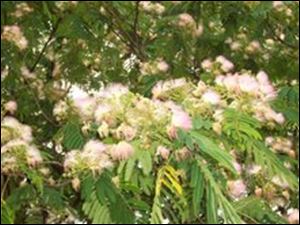
Mimosa tree can thrive in our climate
7/16/2008I got an e-mail from Tim Rhome in Milford, Ohio, that had me hitting the books. He writes, "I have been unable to identify a tree growing in my back yard in Milford, Ohio." Thanks for your e-mail, Tim. It kept me up for a week!
I knew I had seen the tree before. His e-mailed picture kept swirling in my mind as I drove to work and back home again. After about six sleepless nights I drove past one on the way into my Onsted, Mich., neighborhood. A mimosa!

Mimosa tree
The first thing that usually comes to mind might be that refreshing cocktail of orange juice and champagne. And this fancy tree looks like that frothy fruity drink tastes.
The reference books also call it the Persian Silk tree, and in Latin, Albizzia julibrissin. It shoots out crazy pom-pom blossoms that are fragrant and very beautiful. Birds, butterflies, and other nectar-seeking creatures also love this tree. It will bloom from May through late July. Then the blooms give way to colorful fruits that hold seeds that hang on until February.
The other part I love about this tree is the foliage. It almost looks like a sensitive plant that collapses to the touch. The sensitive plant is called Mimosa pudica Their names may be similar, but they aren't related in the plant family. The more proper name for the mimosa tree is Albizia. The foliage is small and grows like a fern. Scientists call this type of leaf a bipinnate because it is made of hundreds of tiny leaflets. If you look close, some varieties are coated with tiny white hairs that make the foliage look silver.
Sometimes the leaves close at night and the tree's foliage folds up in heavy rain. In Persia, its name means "night sleeper," and the Japanese call it "sleeping tree."
How about the good news first. Mimosa trees can spread fast and usually their seed pods float in the water downstream if they grow near wet areas. Ohio State University arborists say one mimosa tree can grow a couple hundred thousand seeds every year.
The bad news is, that kind of easy sprouting, with hundreds of thousands of seed pods, could endanger other native species. So if you see too many mimosa trees growing in one area, pull the seedlings out or give them a shot of a systemic herbicide. Keep the tree population in check and don't share it with your neighbors so it doesn't get out of control.
They can be fast growers, sprouting up to 30 feet on a single trunk with smooth gray bark. It is native to Asia and Africa, so it is very hardy in warmer climates. It's a Zone 6 plant and it can be tough to grow in our cooler Zone 5 climate in southeast Michigan and northwest Ohio. But as both Tim Rhome and my neighbor have proven, it can be done. Now, pass the orange juice!